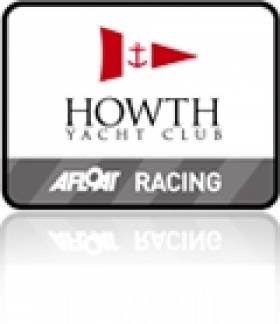Displaying items by tag: Demelza
#cruiserracing – The opening day of the ICRA Nationals at the Royal Irish YC in Dun Laoghaire offered W M Nixon the chance of a painless transition through Friday 13th, and the discovery that there is a life after spinnakers.
In the complete absence of any completely new boats in the hundred-plus lineup for the Irish Cruiser Racing Association's three day Nationals on Dublin Bay, it made sense to focus instead on the lovingly maintained and upgraded veterans in the fleet by sailing on a boat which has been an important part of the Irish sailing story since 1979.
The 30ft Club Shamrock Demelza (she's named after the heroine of a long-forgotten TV drama series based in Cornwall) was one of ten or so boats which raced as a hyper-keen almost one design class in Crosshaven in the late 1970s and early '80s.
Ron Holland's Shamrock Half Tonner design had been achieving racing success since it appeared in 1975, with Silver Shamrock – skippered by Harold Cudmore with all the usual suspects in the crew – winning the Half Ton Worlds at Trieste in 1976. But although they were able little boats with adequate accommodation – American sailor Stuart Woods crossed the Atlantic single-handed in one – the more clubbable element in Royal Cork persuaded the designer and the builders in Cork that a Shamrock with roomier accommodation made possible by a much larger coachroof, with a shorter cockpit and wheel steering, would better meet the needs of club sailors.
For the more austere racing types, the Club Shamrock which emerged from all these discussions looked to be a frivolous boat for party animals, rather than a serious racing proposition. But it speaks volumes for the basic quality of the Ron Holland hull design that the "comfy party boats" could hold their own very well indeed inshore and offshore, if competently sailed.
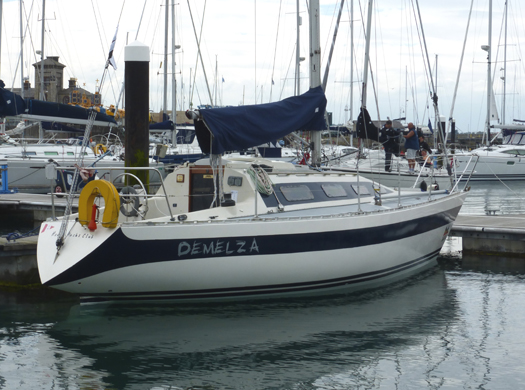
The pintail stern on Demelza makes her very slippy to windward, but her performance suffers on a reach. Photo: W M Nixon
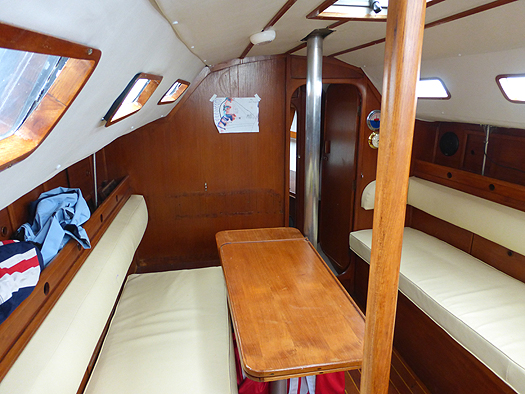
The Club Shamrock version provided a saloon which seemed exceptionally roomy in the 1970s. Photo: W M Nixon
Thus Brian MacManus of Dun Laoghaire, who owned and campaigned Silver Shamrock herself for ten keenly contested offshore seasons in the Irish Sea, remembers that it was the devil's own job getting clear ahead of the almost clunky-looking Club Shamrocks, and it was wellnigh impossible when that Club Shamrock was Demelza, owned and sailed by Neville Maguire.
But we're getting ahead of the story. Back in 1979, Demelza was a new build for Stafford Mansfield of Crosshaven. A key member in his crew was his schoolboy son Mark, later an Olympic sailor and still very much in demand as a frontline helmsman. But back in the late 1970s, it was Demelza which propelled young Mark into the offshore racing game.
He modestly recalls that they won more than their fair share of prizes. But as the boat was raced with complete dedication, there was nothing unfair about their haul of trophies. Eventually, with their sights on the db1 Luv Is, the Mansfields sold Demelza on to Neville Maguire of Howth, thereby bringing another name of international sailing repute into the story, as it was aboard the little boat that Gordon Maguire made early forays offshore.
However, Demelza could win whether Gordon was there or not. In 1984, on the very weekend in August that saw Gordon winning the Irish Windsurfer Nationals in Kerry, in the Irish Sea Neville won the concluding race of the ISORA Championship to take the title – and that in a year in which he had also won his class in the Round Ireland.
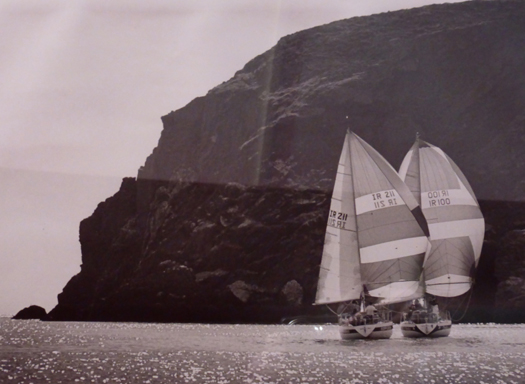
Glued together. Harry Byrne's Club Shamrock Rapparee and Neville Maguire's sister-ship Demelza in one of their many contests during the 1980s, seen here closing in under Howth Head while positioning themselves for the lee mark.
The Club Shamrocks found a new lease of life in Howth, and for many years a feature of the racing there was the continuing battle between the sister Club Shamrocks, Harry Byrne's Rapparee and Neville Maguire's Demelza. They seemed to be glued together in some races, and years afterwards they can still recall every last move afloat, and the final outcome of dozens of contests.
Neville Maguire had long since celebrated his 80th birthday when he sold Demelza to Windsor Laudan and Steffi Ennis for what is only the third ownership in the boat's gilded existence. Steffi Ennis is longtime Howth sailing family, while Windsor is Irish Sea through and through. His boyhood was spent at picturesque Porth Dinnllaen in North Wales, where his parents ran the famous pub on the beach, then when he was 16 they moved to Holyhead and he became so involved in offshore racing that after zillions of crossings of the Irish Sea, he became Howth based.
Demelza is one very lucky little ship, so where better to spend Friday 13th June? In Windsor and Steffi's ownership, she has people who appreciate her good qualities, which are many, for she's one gallant little boat. And as for the fact that when the spinnaker is set the Shamrock can be a right handful, well, they've solved the problem simply by opting to keep her as a much-loved family cruiser while racing her in the non-spinnaker class.
That said, they've raised non-spinnaker racing to a new level. Last year, they were right on the pace, winning the Lambay Lady for the clearest win in Howth's annual Lambay Race, and topping their class with six bullets in the Volvo Dun Laoghaire Regatta. All this despite the fact that the Club Shamrock's very pintailed hull is at a distinct disadvantage when reaching, or when running in anything over Force 4. So clearly this pair of keen owners are employing some very special skills, and the opening day of the ICRA Nats offered an opportunity to find out just how they do it, and also to get the flavour of this year's main regatta on the east coast.

Good start to the day. With Howth Head well astern across Dublin Bay, the rest of the crew catch up with the commuter boat as Demelza enters Dun Laoghaire Harbour.
Photo: W M Nixon
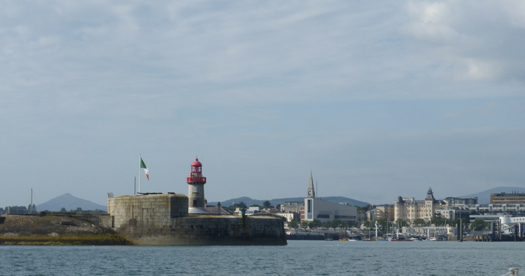
The intrusion of the new library into the Dun Laoghaire waterfront is a shock for those who haven't seen it before. Photo: W M Nixon
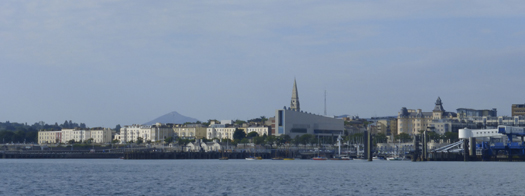
It is only from mid-harbour that you're fully aware of the damage done by the new library to Dun Laoghaire's classic waterfront. Photo: W M Nixon
Being on time is a good start. Ship's orders for visiting journos were to be aboard with the skipper and mate by 0800 in Howth Marina, and get the boat to Dun Laoghaire Marina comfortably in time for the rest of the crew coming across Dublin Bay in a fast runabout which would subsequently be used for daily commuting while the boat stayed on in Dun Laoghaire, all to be well in time for first gun at 1055hrs.
The sense of anticipation is palpable, and while the sight of the new "library and cultural centre" blighting the Dun Laoghaire waterfront was a shock for those who hadn't been it before, at the Royal Irish the happy morning mood took over again, with the place ahive with activity which is comprehensible only to regular regatta racers, and confusing for those not in the loop.
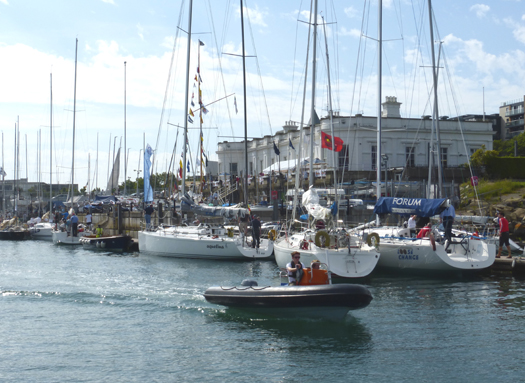
"Glad morning again". The Royal Irish YC is the perfect setting for that special pre-regatta sense of anticipation. Photo: W M Nixon
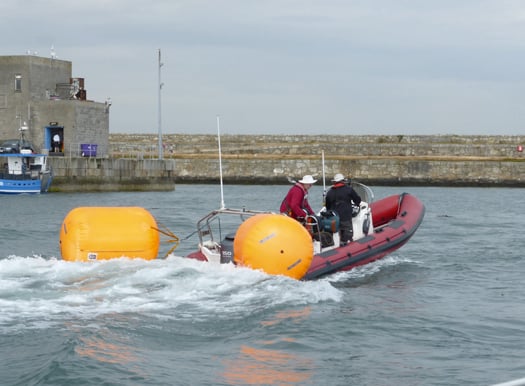
The Dun Laoghaire regatta machine swings into action with supplementary race marks heading seaward. Photo: W M Nixon
Sufficient to say that once again the mighty Dun Laoghaire regatta machine was moving smoothly into action with three different race areas being provided in the bay, and on the waterfront the club gearing up to receive a host of hungry and thirsty post-race sailors. There was a nice moment when Mark Mansfield – up in Dublin to helm John Maybury's J/109 Joker II in the Nationals – called over to say Demelza had never looked better. Other old friends to meet and greet - do other sports have quite the same level of banter as sailing? – and then out to the Bay and suss up the opposition.
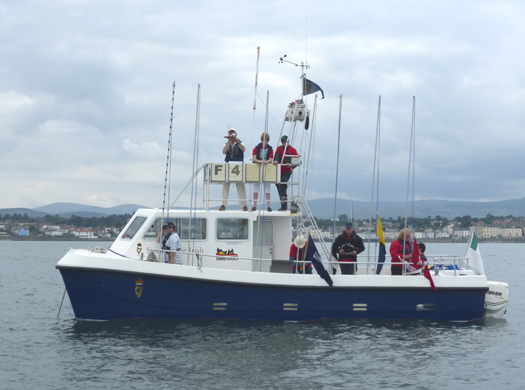
Were it not for the many volunteers manning the committee boats, an event like the ICRA Nationals simply couldn't happen. Photo: W M Nixon
There were two obvious boats in Class 6 for Demelza to beat – Jim McCann's Mustang 30 Peridot, and Sean and Kristina O'Regan's Dehler 31 Vespucci. But an unexpected addition to the lineup of ten or so boats was Frank Friel's Fist 32s5 Effex II, usually completely a cruiser and thus given a low ECHO handicap. So she was in among smaller craft, but this provided another handy target boat for the Laudan-Ennis team.
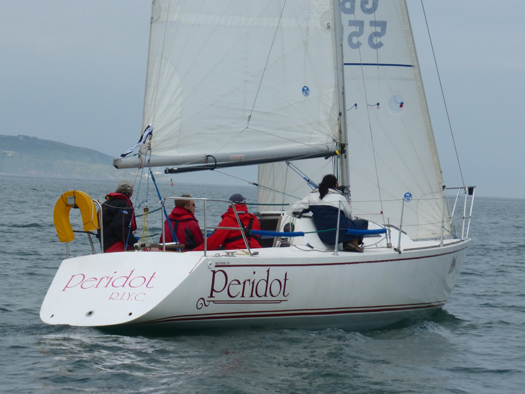
Jim McCann's Peridot was an ideal competitive match for Denmelza. Photo: W M Nixon
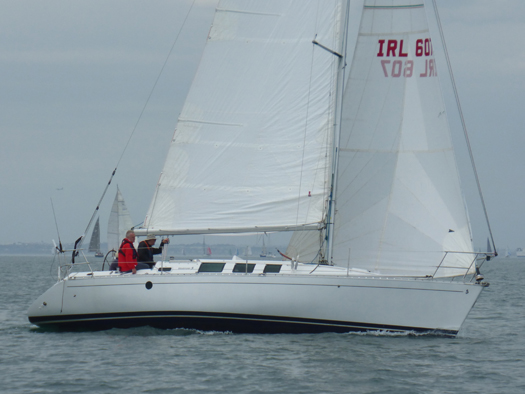
Frank Friel's Effex II took line honours in the first race. Photo: W M Nixon
And that's exactly what they are. A team. It worked beautifully in the countdown to the start, with Steffi putting the course on cockpit display and keeping tabs on time and any other messages via VHF, while Windsor was able to settle into the developing day, getting a sense of what the wind was trying to do while exchanging ideas with his afterguard of Conor Walls and Francis Ennis (Steffi's dad).
They set a hot suit of brown sails on Demelza's masthead rig, with a main from North while the genoa is Philip Watson. Within the limits of doing without spinnaker, everything is optimised and the light breeze from southeast, sometimes swinging a bit more east, is getting a useful bite to it as the first of the ebb is running southeast across our start area in the outer water of Scotsmans Bay.
As is usually the case, in these conditions on the initial beat it pays to go to the wall, closing the shore with Demelza powering along and loving it - after a good start, our skipper finds clear wind and makes the most of it. Fortunately the downwind leg become a dead run, and a masthead-rigged boat can make hay running goosewinged, but even so our lead is under increasing threat from the First 32s5, and Effex II just pips us for line honours, though on IRC Demelza has it by a mile.
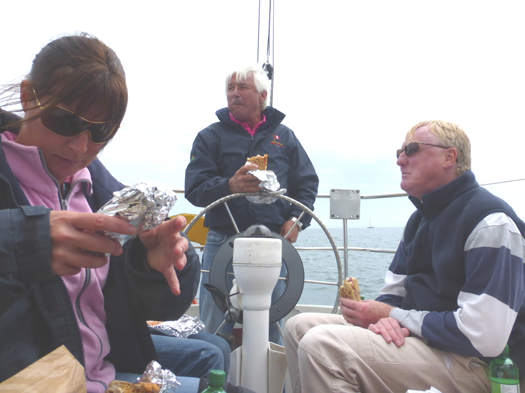
Lunch break – but definitely no alcohol until racing is finished for the day. Photo: W M Nixon
The mood over lunchtime sangers is of good work done, but more work still to do. But then that wretched new library intrudes again. You just can't get away from it. While it looks bad enough from within the harbour, from Scotsmans Bay it looks ten times worse. Out there, you can see how it has entirely blocked off a pleasant terrace of classic Dun Laoghaire waterfront houses from any enjoyment of the sunset. Compared to this new monstrosity, the Berlin Wall was surely a lovely creation.
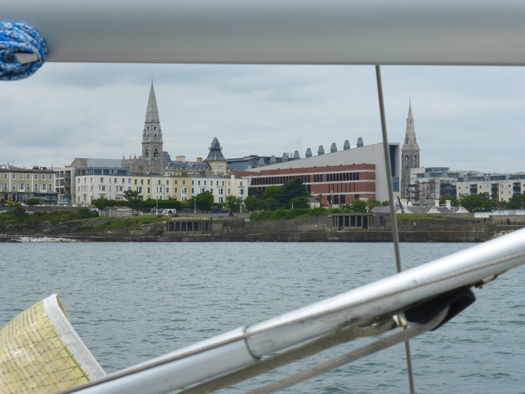
You just can't get away from it..........
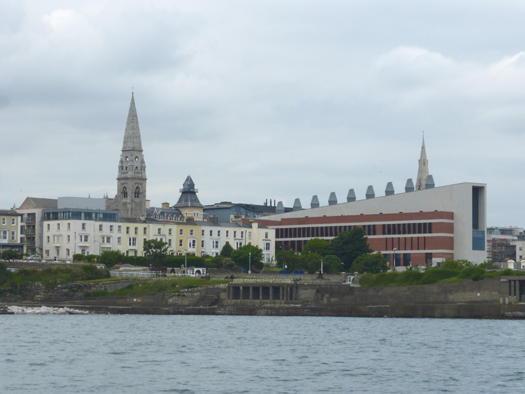
.........and farewell, Sunset Strip. The new Dun Laoghaire library has permanently blocked off the sunset for an entire terrace of houses. Photo: W M Nixon
But fortunately for our entertainment, we had a glimpse of other divisions racing, with Classes 0 and 1 running past nearby, and Denise Phelan's Ker 37 Jump Juice up from Cork doing great things on the run to make up lost ground. For the biggies as for us, the beat out of Dublin Bay was tactically fascinating as the ebb had reached full strength. Jump Juice read it to perfection, even if her winning tack on port brought her right through our starting area.
But once again the Dun Laoghaire regatta machine took it all calmly in its stride. And when we came to make our start, our skipper read it spot on, working his timing and the sluicing ebb to such an accurate level that we swept by the committee boat only a nano-second after the signal, and had congratulations from a race officer for getting it just right.
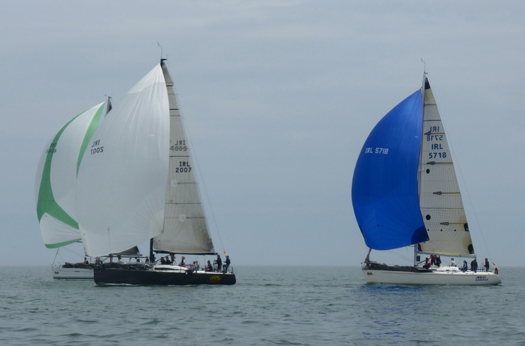
Jump Juice from Cork starting to make up lost ground on the run in Class O Photo: W M Nixon

Winning tack. Jump Juice came down the bay in impressive style hard on the wind............Photo: W M Nixon
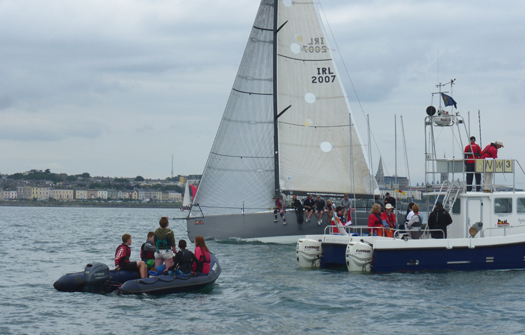
...........and her win move took her right through the Class 5 and 6 start area, but nobody batted an eyelid............Photo: W M Nixon
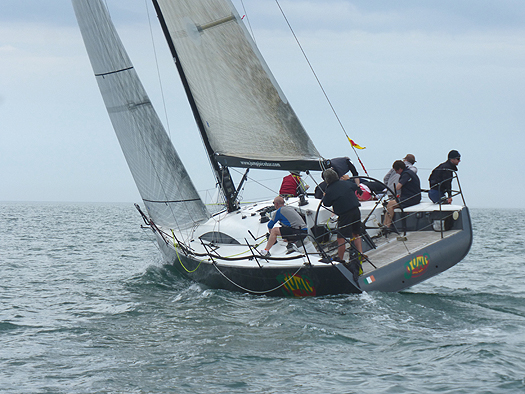
.....and it gave us an exciting glimpse of a top level racing machine. Photo: W M Nixon
That second race saw us sharing some sea space on the run with Classes 0 and 1, and as we were on starboard and interested only in maintaining our lead, some very expensive floating hardware had to throw some very neat gybes to allow the little Demelza to progress on her rightful way. But our afterguard being total boat addicts, they enjoyed nothing more than giving chapter and verse on each boat which came within range.
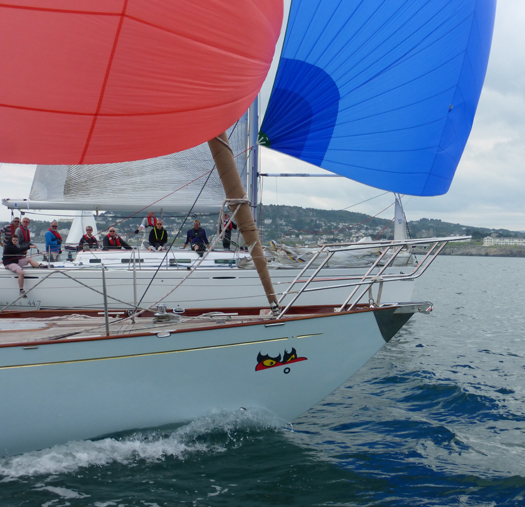
Mixing it with the heavy metal. The bows of the 54ft Soufriere and the 45ft Lively Lady after they'd neatly gybed their way out of a close encounter with the right-of-way Demelza. Photo: W M Nixon
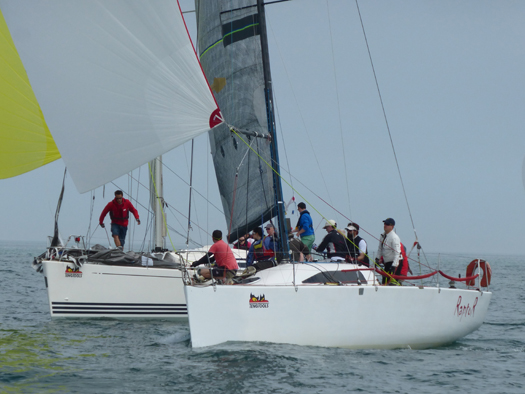
Raptor getting up to speed. She was one of the earliest Mark Mills designs, and was originally known as Aztec. Photo: W M Nixon

Tony Fox's Gringo, an A35, finds some sun on Dublin Bay. Photo: W M Nixon
The final beat saw Jim McCann with Peridot almost getting through, but sailing is a supposedly genteel sport which can show a discreetly killer side, so Windsor and Steffi were only delighted to throw a slam dunk right on top of their old friend, and go on to take line honours and their second corrected time win of the day.
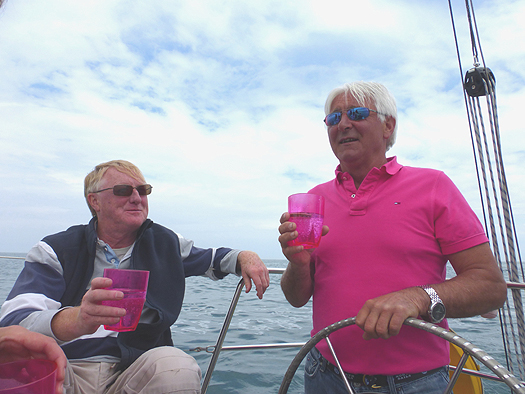
Second win, and line honours too – a bit of celebration for Conor Walls and the skipper. Photo: W M Nixon

Demelza's current success is put down to the permanent presence on board of a lucky Welsh dragon. Photo: W M Nixon

A crew of friends – racing Demelza to success are (front row, left to right) Windsor Laudan, Steffi Ennis and John Aungier, back row Francis Ennis, Conor Walls and Debbie Faherty Photo: W M Nixon
The morning's sunshine had given way to a silver-grey blandness in the weather, and to a casual observer, there might have seemed some blandness to the day's racing. But not for those taking part. I've long thought that trying to make sailing a spectator sport is a waste of time – either you take part, or you go off and watch something exciting like gardening. We'd had a marvellous day's sport, and it was followed by the usual high-octane banter at the club. The ICRA Nationals 2014 had got off to a good start. The race officers had their beloved results, with only one more race to sail to have a recognised championship. Let's hope the sun comes out today to sharpen up the sea breeze. Meanwhile, it was only after I got home I remembered it had been Friday 13th. And as for spinnakers? Well, believe me, there's life after spinnakers, there really is.
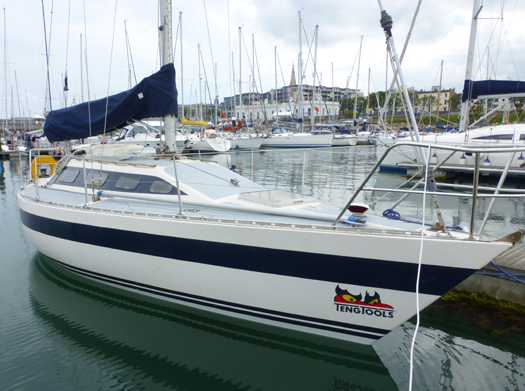
A well-loved little boat at rest after a good day's racing. In her successful 35 years, Demelza has been in only three ownerships. Photo: W M Nixon




























